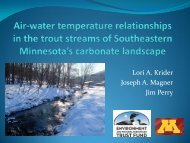Minnesota Water Resources Conference - Water Resources Center ...
Minnesota Water Resources Conference - Water Resources Center ...
Minnesota Water Resources Conference - Water Resources Center ...
You also want an ePaper? Increase the reach of your titles
YUMPU automatically turns print PDFs into web optimized ePapers that Google loves.
Concurrent Sessions V 1:15–2:45<br />
BOOK OF ABSTRACTS<br />
Wednesday, Tuesday, October 24 28 23<br />
Track E: Storm <strong>Water</strong> Monitoring: Cool Case Studies and Updating Particle Size Data<br />
Paired-<strong>Water</strong>shed Assessment of Retrofitted Stormwater Volume Reduction BMPs<br />
Kristy Treichel, City of River Falls, ktreichel@rfcity.org; Rich Brasch, Bonestroo; and Reid Wronksi, City of River Falls<br />
This presentation reports on retrofitting small-scale volume reduction practices into an older city<br />
neighborhood. The City, Trout Unlimited, Kinnickinnic River Land Trust, Kinnickinnic Priority <strong>Water</strong>shed,<br />
WiDNR, and private property owners worked together on this demonstration project with the following<br />
objectives:<br />
1. Survey the willingness of property owners to make changes on their property to better manage stormwater.<br />
2. Design and implement a variety of retrofitted infiltration BMPs within the public right-of-way.<br />
3. Monitor stormwater runoff from control and experimental paired-watersheds, before and after BMP<br />
installation.<br />
4. Use project outcomes to:<br />
a. gauge the feasibility of small-scale retrofit practices<br />
b. understand the actual benefits of volume reduction BMPs<br />
c. guide the City’s implementation of infiltration BMPs in other areas<br />
BMPs implemented include:<br />
■■<br />
Mowable grass infiltration basins<br />
■■<br />
Rainwater gardens<br />
■■<br />
Porous concrete gutters<br />
■■<br />
Porous paver alleys<br />
■■<br />
Rain barrels<br />
■■<br />
Rain gutter redirection<br />
Local Urban Stormwater Monitoring, Results and Implications for Future Management<br />
Katie Huser, Capitol Region <strong>Water</strong>shed District, katie@captiolregionwd.org; and Melissa Baker, Capitol Region <strong>Water</strong>shed<br />
District<br />
Capitol Region <strong>Water</strong>shed District (CRWD), located in Ramsey County, is completely urbanized, with 42%<br />
coverage by impervious surfaces and is drained almost solely by storm sewers. CRWD began its water quality<br />
monitoring program in 2005 with 8 stormwater water quality monitoring stations and has grown to 18 stations<br />
in 2008. At each station, flow is measured continuously and composite water quality samples are collected<br />
during storms and baseflow. <strong>Water</strong> samples are analyzed for nutrients, solids and metals. Results are discussed<br />
for 10 subwatershed stations. Pollutant loadings and yields are calculated for TP and TSS. With no water<br />
quality standards for stormwater, flow weighted average concentrations are compared to concentrations in the<br />
receiving waters (Mississippi River), to surface water quality standards and national averages for stormwater.<br />
CRWD is now assessing how monitoring data compares to model predictions and what our results mean for<br />
load reductions required by future TMDLs.<br />
<strong>Minnesota</strong> <strong>Water</strong> <strong>Resources</strong> <strong>Conference</strong>, October 27–28, 2008 74
















